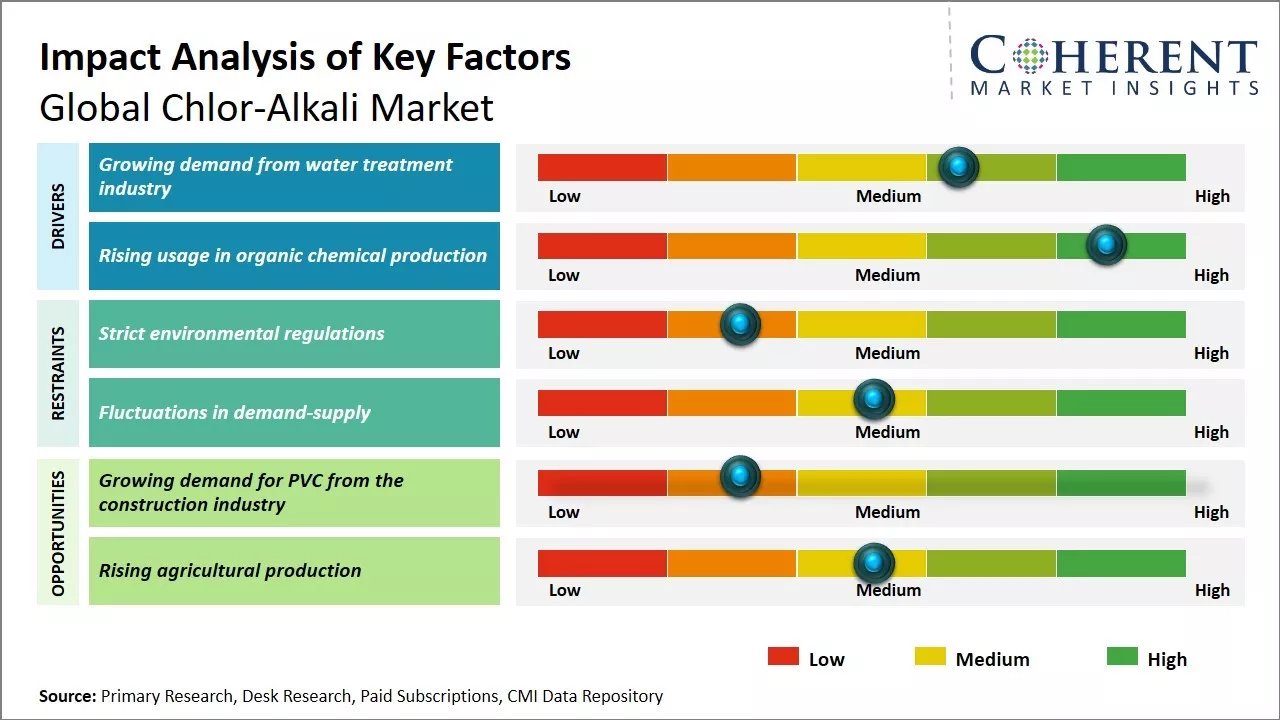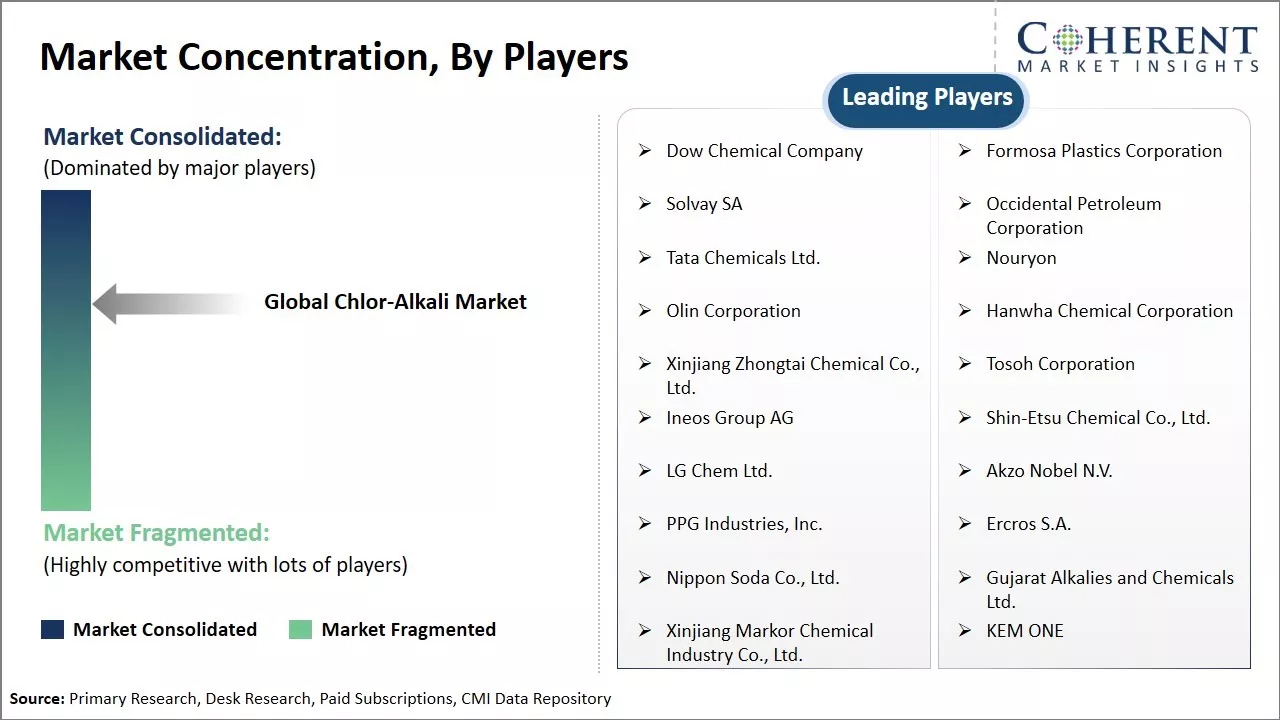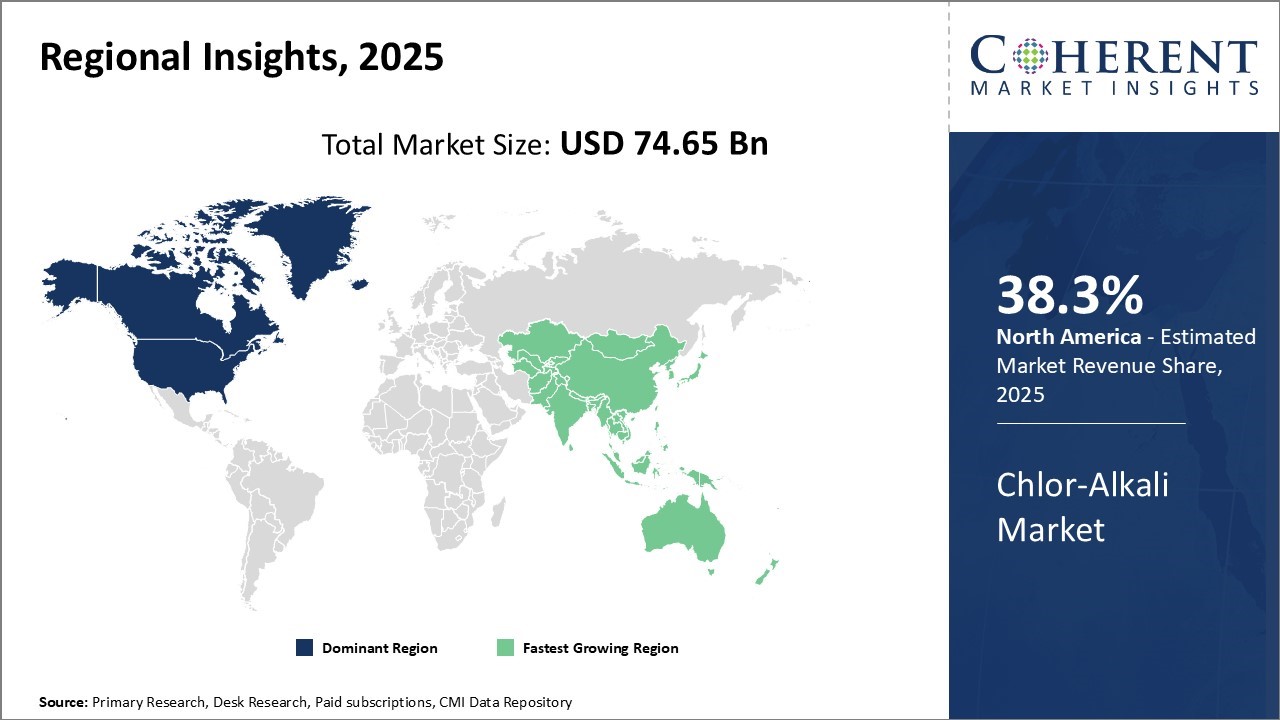The global chlor-alkali market is estimated to be valued at USD 74.65 Bn in 2025 and is expected to reach USD 100.98 Bn by 2032, growing at a compound annual growth rate (CAGR) of 4.4% from 2025 to 2032.

To learn more about this report, Download Free Sample
The Global Chlor-Alkali Market is expected witness steady demand driven by growth in end-use industries such as chemical processing, water treatment, pharmaceutical, paper & pulp and others. Within the chemicals industry, chlor-alkali is a critical building block material that serves as a key raw material for the production of numerous essential chemicals including polyvinyl chloride (PVC), ethylene dichloride (EDC), caustic soda, alumina, and titanium dioxide among others. Rapid industrialization and infrastructural development activities across emerging economies are expected to drive the demand for such derivatives, supplementing revenue generation in the global chlor-alkali market over the coming years.
|
Event |
Description and Impact |
|
China's Economic Slowdown and Industrial Policy Shifts |
|
|
Global Energy Crisis and Natural Gas Price Volatility |
|
|
Rising Environmental Regulations and Sustainability Mandates |
|
Uncover macros and micros vetted on 75+ parameters: Get instant access to report

To learn more about this report, Download Free Sample
The growing global population and urbanization are positively impacting the water treatment industry. People’s access to clean drinking water directly affects their health, making it a vital issue. The chlor-alkali industry is benefitting from this as chlorine and sodium hydroxide are extensively used in water treatment systems. Chlorine serves as a disinfectant to eliminate bacteria and other microorganisms that may contaminate water. It is a strong water sterilizing agent and helps purify water that is delivered to homes and industries.
Globally, both developed and developing countries have been increasing the use medicinal chlorine for water treatment. For instance, as UNICEF reported in 2020, more than 800 million people lacked basic drinking water services, and water disinfection systems require further strengthening.
As more communities are to be provided access to safe water in coming years, the consumption of chlorine is projected to rise further. In addition to chlorine, the increasing complexity of water generated from various sources like surface water, seawater, and industrial wastewater has necessitated advanced treatment methods that employ caustic soda (sodium hydroxide) on a large scale.
Sodium hydroxide serves the purpose of pH balancing and eliminating heavy metals through coagulation and precipitation processes. It is important in the secondary and tertiary stages of water treatment. With sodium hydroxide being extensively used in water treatment, there is expected to be great change in the usage of sodium hydroxide for water treatment industrially over the next ten years. This is expected to support the growth of the chlor-alkali industry.
According to UN Water reports, the world is running out of freshwater. Industrialization, pollution, and climate change are responsible for water scarcity in various regions of the world. The sodium hydroxide market in the water treatment industry is anticipated to boost considerably in the next decade. This is good news for the chlor-alkali industry as whole.
Production of a variety of organic chemicals is another significant end-use sector where chlor-alkali chemicals are applied. Chlorine serves as a precursor or a raw material for several commodity chemicals, including vinyl chloride monomer (VCM), ethylene dichloride (EDC), polyvinyl chloride (PVC) resins, ethylene, propylene oxide, and others. These chemical intermediates are further processed into components for a multitude of industrial and consumer goods.
In supported regions, the global production of organic chemicals surged recently as a result of expanding markets like consumer durables, automotive industry, packaging, construction, and agrochemicals. There is also growing manufacturing activity in Asia Pacific and Latin America, which further stimulates domestic demand for organic chemicals alongside the international demand.
To expand access to domestic and foreign clients, chemical companies are investing heavily in facilities that produce organic chemicals. As this increase in production happens, the worldwide demand for chlorine and chlor-alkali products will continue to experience vigorous growth.
The construction industry’s increasing need for PVC creates a significant opportunity for expansion within the chlor-alkali market at a global scale. Due to its diverse characteristics and cost effectiveness, PVC or polyvinyl chloride is one of the most popular plastics in the construction industry. It is simple to cast into different shapes such as pipes, window frames, siding, flooring, and even as insulation boards.
Some numbers illustrate the sheer magnitude of construction projects taking place globally and the surge in demand for PVC. As reported by the United Nations, the global spending on infrastructure is projected to reach USD 94 trillion by 2040 for the building of roads, bridges, utilities, among other construction requisites. This will be due to accelerated urbanization where people move to cities for better living standards and job opportunities.
Asia and Africa are expected to account for roughly two thirds of all infrastructure spending in the next 20 years. China alone has plans for over USD 12 trillion in new projects by 2030. As development-stage economies focus on more housing, transport, and energy facilities, the availability of PVC materials will have to meet demand.
In terms of product, soda ash is expected to contribute 53.8% share of the market in 2025 owing to its increasing use in the flourishing pulp and paper industry. Soda ash, also known as sodium carbonate, acts as an important raw material in the manufacturing of paper. It has alkalinity properties that help remove lignin from wood fibers to extract cellulose needed for paper production. With more nations pushing initiatives to reduce reliance on plastics and increase paper product usage, pulp and paper companies are ramping up capacities. This bodes well for soda ash demand.
Additionally, growing e-commerce is propelling corrugated packaging board demand, another major end-use for soda ash. Further, favorable government policies in developing nations supporting local paper industries also aids the soda ash market. Its cost-effectiveness relative to substitute products cements soda ash's dominant position
In terms of production process, membrane cell is expected to contribute 43.8% of the market share in 2025 owing to its technology advantages over traditional processes. Membrane cell technology provides higher energy efficiency and yields compared to diaphragm cell methods. It allows producers to reduce operating costs and lower carbon footprint.
Additionally, membrane cells offer improved safety with reduced risk of gas leaks. Their modular design also enables easy capacity expansions. With sustainability and cost savings in sharp focus, many chlor-alkali companies are retrofitting plants or constructing new production facilities based on advanced membrane cell systems.
Government incentives for green technologies further accelerate widespread adoption. R&D continues to enhance membrane cell performance, helping cement its position as the preferred production process.

To learn more about this report, Download Free Sample
North America is projected to maintain a leading position in the global chlor-alkali market through 2025, with the region expected to account for 38.3% of total market share. This dominance is underpinned by North America’s mature industrial infrastructure and the strong presence of end-use sectors such as chemicals, pulp & paper, pharmaceuticals, and municipal water treatment.
Major chlor-alkali producers operate extensive manufacturing networks across the U.S. and Canada, ensuring a steady supply to domestic industries and facilitating exports to nearby markets such as Latin America.
The region benefits from abundant access to raw materials and reliable energy sources, allowing manufacturers to maintain competitive production costs. However, the enforcement of stricter environmental regulations—particularly around mercury cell technology—has led to increased compliance costs for producers. Despite these regulatory challenges, the demand for caustic soda, chlorine, and related derivatives remains stable, driven by continued industrial consumption and the region’s strong export orientation.
Asia Pacific is expected to emerge as the fastest-growing chlor-alkali market globally, driven by robust industrialization, infrastructure expansion, and growing demand from downstream sectors. Countries such as China, India, Indonesia, and Vietnam are witnessing a rapid rise in chemical, construction, textile, and water treatment activities—boosting the consumption of chlorine, caustic soda, and potassium hydroxide across the board.
This surge in demand is prompting chlor-alkali manufacturers to expand existing facilities and establish new production units to serve regional needs. While China currently dominates chlor-alkali exports within Asia Pacific, other ASEAN economies are quickly gaining attention as emerging hubs for both production and consumption. Moreover, regional markets increasingly import chlor-alkali products from Persian Gulf nations to meet short-term demand surges, further diversifying their sourcing strategies.
With growing urbanization, a rising middle-class population, and favorable economic policies, Asia Pacific’s chlor-alkali market is poised for continued growth over the forecast period, outpacing more mature markets in volume and capacity additions.
The United States leads the North American chlor-alkali market, supported by well-established production infrastructure, access to shale gas-based energy sources, and strong demand from a wide range of downstream industries. Major players operate fully integrated facilities and benefit from scale efficiencies, making the U.S. a cost-effective supplier of chlor-alkali products both domestically and internationally. Regulatory developments are prompting a shift toward more sustainable technologies, with companies gradually phasing out older mercury-based processes.
China is the largest contributor to Asia Pacific’s chlor-alkali growth, fueled by its vast manufacturing base and expanding demand in sectors such as plastics, textiles, construction, and electronics. The country continues to invest in modernizing production technologies and increasing output to support both domestic consumption and exports. Despite challenges such as tightening environmental standards, China's strategic position as a global supplier and regional demand center makes it a critical driver of market dynamics across Asia Pacific.
| Report Coverage | Details | ||
|---|---|---|---|
| Base Year: | 2024 | Market Size in 2025: | USD 74.65 Bn |
| Historical Data for: | 2020 To 2024 | Forecast Period: | 2025 To 2032 |
| Forecast Period 2025 to 2032 CAGR: | 4.4% | 2032 Value Projection: | USD 100.98 Bn |
| Geographies covered: |
|
||
| Segments covered: |
|
||
| Companies covered: |
Dow Chemical Company, Formosa Plastics Corporation, Solvay SA, Occidental Petroleum Corporation, Tata Chemicals Ltd., Nouryon, Olin Corporation, Hanwha Chemical Corporation, Xinjiang Zhongtai Chemical Co., Ltd., Tosoh Corporation, Ineos Group AG, Shin-Etsu Chemical Co., Ltd., LG Chem Ltd., Akzo Nobel N.V., PPG Industries, Inc., Ercros S.A., Nippon Soda Co., Ltd., Gujarat Alkalies and Chemicals Ltd., Xinjiang Markor Chemical Industry Co., Ltd., and KEM ONE |
||
| Growth Drivers: |
|
||
| Restraints & Challenges: |
|
||
Uncover macros and micros vetted on 75+ parameters: Get instant access to report
Share
Share
About Author
Vidyesh Swar is a seasoned Consultant with a diverse background in market research and business consulting. With over 6 years of experience, Vidyesh has established a strong reputation for his proficiency in market estimations, supplier landscape analysis, and market share assessments for tailored research solution. Using his deep industry knowledge and analytical skills, he provides valuable insights and strategic recommendations, enabling clients to make informed decisions and navigate complex business landscapes.
Missing comfort of reading report in your local language? Find your preferred language :
Transform your Strategy with Exclusive Trending Reports :
Frequently Asked Questions
Joining thousands of companies around the world committed to making the Excellent Business Solutions.
View All Our Clients